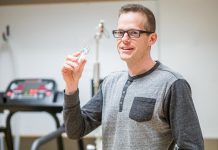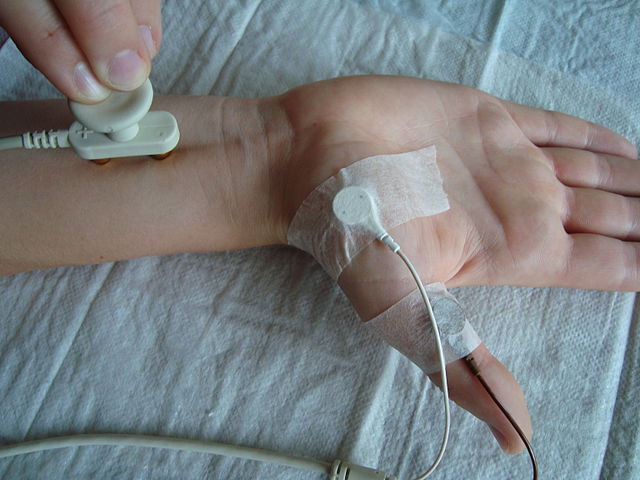July 2004 - After a series of studies in the laboratory of Dr. Gregory Freund, a clearer picture is emerging: A disruption of signaling proteins in the immune system may be responsible for the inflammation that makes someone with type 2 diabetes feel sick and increases the risk of serious complications.
Freund, the head of the pathology department in the University of Illinois College of Medicine at Urbana-Champaign and a professor of animal sciences in the College of Agricultural, Consumer and Environmental Sciences, is pursuing the theory that inflammation is tied to a disturbance of signal-carrying cytokines.
Type 2 diabetes -- once considered an adult-onset disease -- is an increasing problem alongside obesity, even among teenagers. Some 18 million Americans suffer from diabetes, with more than 90 percent being type 2, according to the Centers for Disease Control. Diabetes costs some $98 billion a year to treat and is the nation's sixth leading cause of death -- usually because of resulting cardiovascular and other complications.
The disease is initially characterized by high levels of insulin in the blood, a condition known as hyperinsulinemia, and insulin resistance, whereby cells refuse to let insulin inside. When that happens, the ability to regulate glucose levels is compromised. A mechanism thought to be a major player in the onset of insulin resistance, Freund said, is serine phosphorylation, triggered by hyperinsulinemia, of the insulin receptor substrates.
This phosphorylation, Freund said, "impacts other signaling cascades in cells, controlled by cytokines, especially ones like interleukin 4, an anti-inflammatory protein."
Continue Reading Below ↓↓↓
A connection to the cytokine IL-4 was documented by Freund and colleagues in a study published July 2 in the Journal of Biological Chemistry. They found that IL-4 signaling was impaired when they tested macrophages (a type of white blood cells) removed from type 2 diabetic mice.
The findings of that study -- funded by National Institutes of Health, American Heart Association, American Diabetes Assocation and University of Illinois Agricultural Experiment Station -- followed similar findings, presented two years ago in the same journal, based on experiments in cell lines.
"In our first paper, we treated cells with insulin in a test tube," Freund said. "In our new paper, we took the macrophages from diabetic animals and looked at the signaling abilities of the insulin receptor substrate 2, and, lo and behold, we indeed saw reduced signaling function."
Freund's co-authors on the new paper were Matthew E. Hartman, Jason C. O'Connor and Jonathan P. Godbout, all of animal sciences; Kyle D. Minor, a first-year medical student; and undergraduate biology-honors student Valerie R. Mazzocco.
New work in Freund's lab shows that cytokine-dependent fever and reduced social exploration is found in type 2 diabetes mice. The neuroimmune response leading to the sickness behavior, Freund said, was linked to hypersensitivity to lipopolysaccharide and potentially to cytokine resistance.
Now Freund is asking what this signaling breakdown in the insulin receptor substrate does in patients. "Such knowledge would be applicable to many other diseases that involve inflammation and subsequent illness behavior," he said.
The growing list of findings has led to a five-year $1.56 million grant, which was awarded to Freund in March by the NIH's National Institute of Diabetes and Digestive and Kidney Diseases. Co-investigators are Robert Dantzer, a professor of animal sciences, and Jeffrey A. Woods, a professor of kinesiology.
There are three goals of the newly funded research, Freund said:
- Determine the physiological relevance of the brain-immune interactions that occur in type 2 diabetes;
- Identify mechanisms that cause the diabetic pro-inflammatory state to inappropriately augment lipopolysaccharide-induced fever and sickness behavior;
- Determine if a potential new drug combination could improve neuroimmune function in diabetic mice.
That potential therapy is based on yet another recent discovery in Freund's lab. Vanadyl sulfate, which now is used to reduce blood sugar content, improves insulin signaling and insulin-dependent glucose uptake in skeletal muscle in mice and speeds recovery from lipopolysaccharide-induced sickness behavior.
Freund theorizes that combining vanadyl sulfate with rapamycin, a drug used to lower the risk of rejection of transplanted kidneys, might reduce diabetes-associated inflammation and stabilize brain-immune system interactions.
Continue Reading Below ↓↓↓
Source: University of Illinois at Urbana-Champaign










